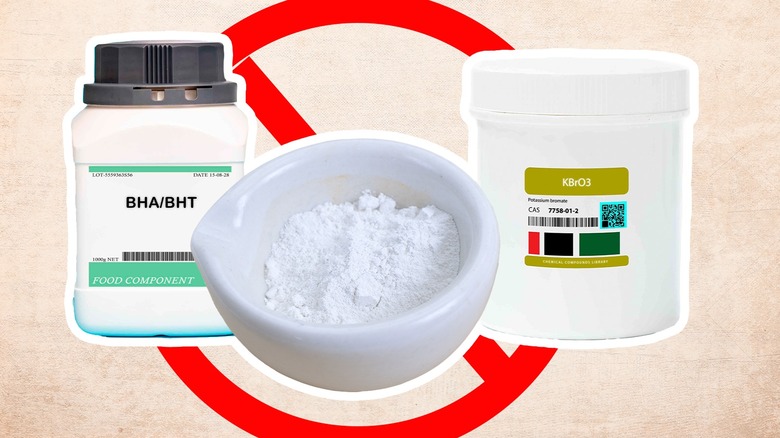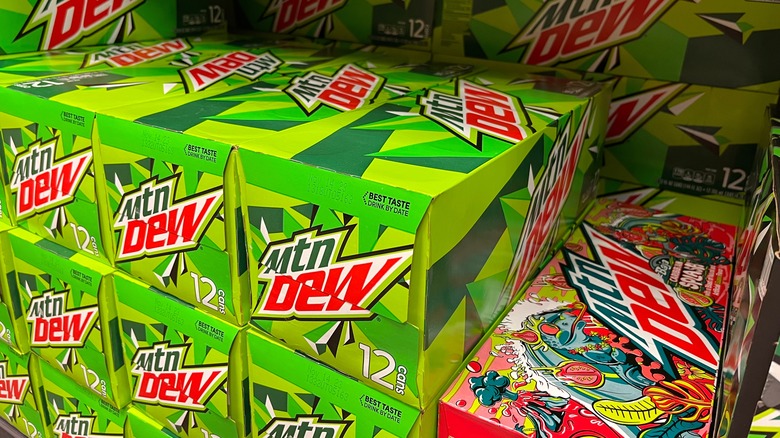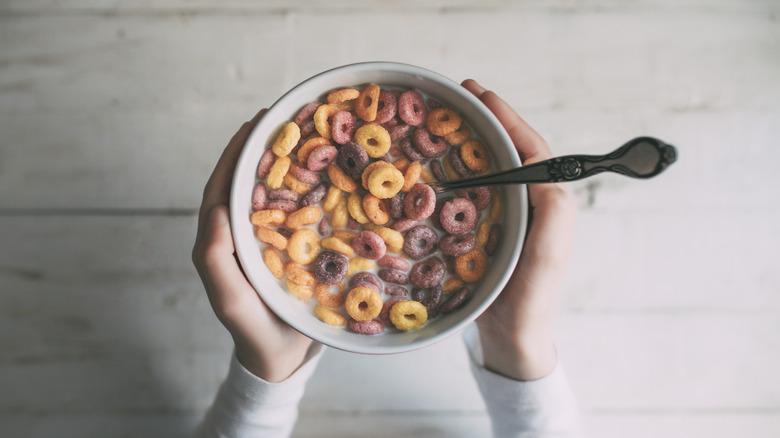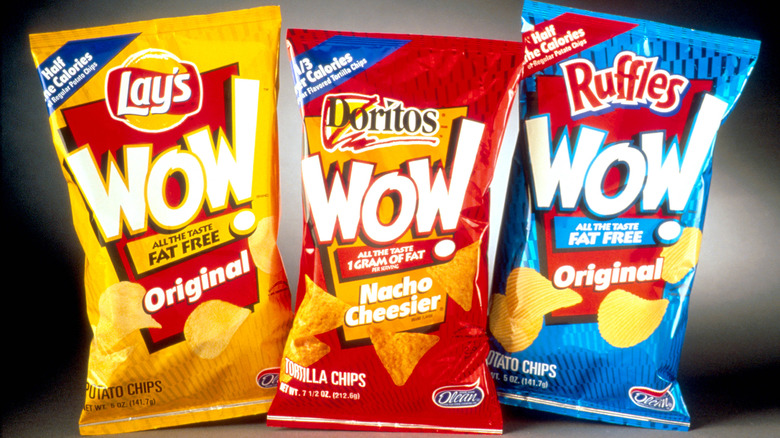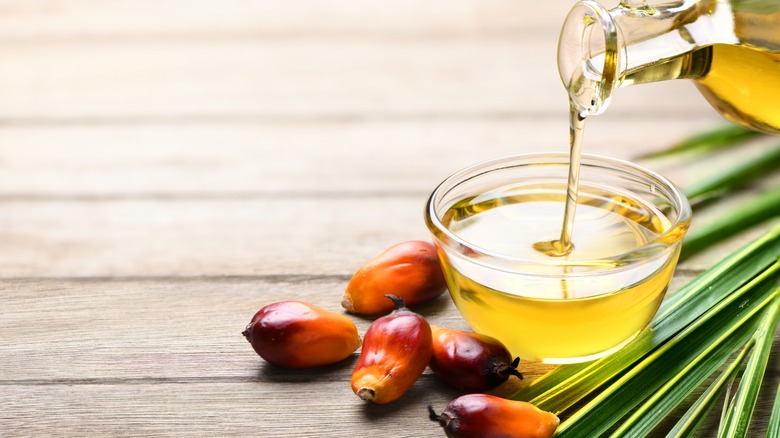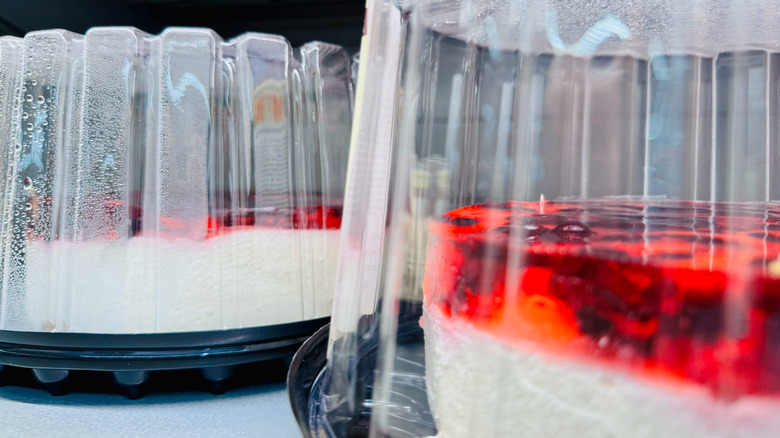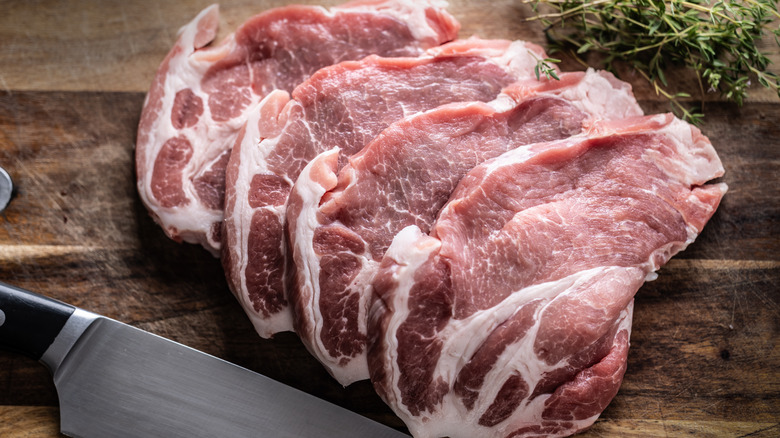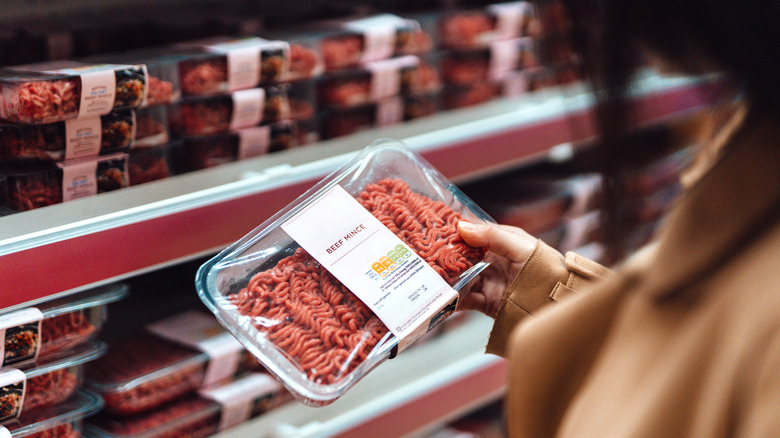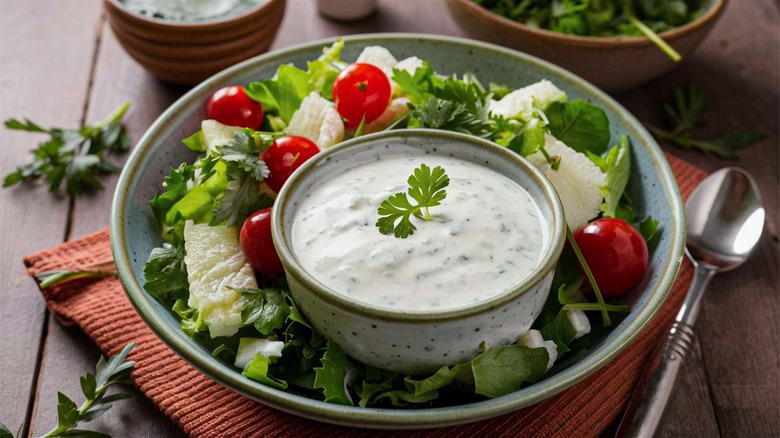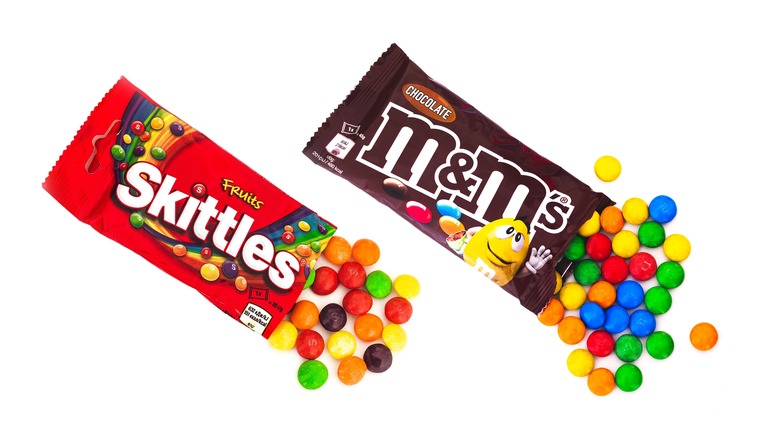13 Foods That Are Banned In Europe But Not In The US
Have you had a friend who visited Europe for a while and raved about how healthy they felt while they were there? They may have even lost weight, even while eating the same amount of food. This is a common experience when people from the U.S. travel abroad, and while there's no definitive reason for it, many suspect it's because the EU bans certain ingredients that the U.S. doesn't.
Many additives and hormones that are present in everyday foods in the U.S. are either banned or heavily restricted in Europe. This is due to the different ways that the Food and Drug Administration (FDA) and the European Food Safety Authority (UFSA) decide which foods should be banned. The EFSA bans foods if there's a valid chance they could cause harm, while the FDA needs to see proof of harm before banning something. As a result, there are several ingredients that are banned in Europe, but not in the U.S.
Azodicarbonamide
About 10 years ago, Subway made headlines for including an ingredient in its bread that is also used in rubbers and plastics. This Subway bread controversy led to people comparing the brand's bread to yoga mats. This was all thanks to azodicarbonamide (ADA), a product used as a blowing agent for rubber and plastics, also used as a bleach for flour and a dough conditioner.
Subway no longer uses the substance, which is an orange-red crystalline solid in its pure form. However, many brands still use azodicarbonamide because the FDA has declared it to be safe. Although not as widespread as it used to be, brands like Bon Appetit and Harvest Pride still use them in some of their bread products.
While the U.S. has declared azodicarbonamide safe, the European Union doesn't agree. The EU has not only banned azodicarbonamide in food products, but has also banned the use of the compound in plastics that are intended to come into contact with food. The major concern with ADA is its potential as a carcinogen. Two breakdown products of ADA, urethane and semicarbazide, are probable carcinogens. Additionally, the World Health Organization (WHO) has found that high doses of azodicarbonamide can negatively affect the kidneys.
Brominated vegetable oil (BVO)
Brominated vegetable oil, or BVO, is vegetable oil that's been modified with the chemical bromine. BVO has been primarily used in citrus drinks as a stabilizer, as it keeps the citrus flavor from floating to the top. For years, you could find BVO in juices and citrus sodas, including Mountain Dew and Sun Drop — but only if you were in the U.S.
If you picked up a Mountain Dew in Europe any time over the last 15 years, it might have tasted just a little different. That's because the EU banned BVO as a food additive in 2008. The thing about bromine is that it's corrosive and volatile. Originally, the FDA labeled it as safe in very small doses, but it had never conducted studies on chronic use. That is, a little BVO here and there is fine, but what about people who drink multiple Mountain Dews every single day?
Through a joint collaboration with the National Institutes of Health, the FDA determined that BVO has a tendency to accumulate in the body and damage the thyroid. Other studies have shown that BVO may lead to neurological, behavioral, and reproductive problems. Earlier this summer, the FDA finally banned brominated vegetable oil as a food additive, 16 years after the EU banned it.
Butylated hydroxyanisole (BHA)
Butylated hydroxyanisole, or BHA, is a solid, waxy petrochemical, meaning it's a chemical made through refining petroleum. It's primarily used as a preservative and can be found in cosmetics, medicines, animal feed, food packaging, and food. Although not as common as it used to be, BHA is still used as a preservative in things like chewing gum, butter, potato chips, baking mixes, frozen meals, and more.
Manufacturers like BHA because it's a cheap, shelf-stable option that keeps food from going bad. The FDA says it's safe in low doses, but the NIH categorizes it as "reasonably anticipated to be a human carcinogen." However, it's unclear exactly at what levels BHA is dangerous, as studies have shown there doesn't seem to be an increase in risk for those consuming typical levels of BHA.
The EU doesn't want to risk it, so along with Japan, Australia, New Zealand, and Canada, it has banned the compound. In the U.K., BHA can't be used in infant food. Additionally, the EU takes it a step further by banning BHA in cosmetics and fragrances as well.
Butylated hydroxytoluene
Closely related to butylated hydroxyanisole is butylated hydroxytoluene (BHT), another butylated compound that's commonly used as a preservative. Like its brother, BHA, it's used in petroleum products, medicine, cosmetics, and food. It's used in many of the same food products, such as cereal, potato chips, chewing gum, frozen meals, and boxed cake mixes.
However, BHT is more widely used than its counterpart. Many well-known brands still use the ingredient, including Kellogg's, Post, Quaker, Lean Cuisine, Stouffer's, and Pillsbury. Additionally, many common beauty brands like Garnier and Paul Mitchell use the compound in their products — and BHT can be absorbed through the skin.
Various studies conducted by the European Food Safety Authority have found that, in animals, BHT is linked to liver tumors, birth defects, reproductive issues, endocrine disruption, thyroid problems, and lung cancer. The product is banned in food in the EU and heavily restricted in the U.K. The FDA allows BHT in foods, but could update its guidelines in the future.
Olestra
Diet culture of the '90s and early 2000s was wild, and nothing demonstrates that quite like olestra. Olesta is a fake fat that bodies can't absorb, and it was used as a fat and oil substitute because it didn't add any calories. Companies primarily added it to food like potato chips to create snacks that were low-fat and low-calorie.
Unfortunately, if it sounds too good to be true, it usually is. Olestra was plagued by one glaring problem: it had a tendency to wreak havoc on the gastrointestinal tract. Not long after it hit the market, the FDA and olestra's parent company, Proctor & Gamble, were flooded with callers reporting stomach cramps, flatulence, diarrhea, and anal leakage. Additionally, studies found that olestra was absorbing key fat-soluble vitamins, like A, D, E, and K. The FDA started requiring companies to add additional fat-soluble vitamins to products made with olestra and put a warning label on products that read, "This product contains olestra. Olestra may cause abdominal cramping and loose stools. Olestra inhibits the absorption of some vitamins and other nutrients. Vitamins A, D, E, and K have been added."
Olestra is banned in the European Union and Canada for these health concerns. While the FDA never banned the use of olestra in the U.S., the fake fat's reputation had already taken a massive hit. Currently, there are no products on the market in the U.S. that use olestra.
Palm oil
Palm oil is a type of vegetable oil that comes from certain kinds of palm trees. It's used in a ton of products, including packaged food, toiletries, cosmetics, animal feed, and biofuel. While palm oil doesn't have any major health effects, like causing cancer or disrupting hormones, it's not the healthiest oil option. That has nothing to do with why it's banned, though.
Both the EU and the U.K. have banned the import of palm oil linked to deforestation. Importers now have to show that the production of palm oil has not led to forest damage. While oil palm trees are native to Africa, Indonesia and Malaysia are currently the world's largest producers of palm oil. Unfortunately, palm oil farms have created deforestation that has destroyed the habitat of several endangered animals.
However, that's not the only ethical problem linked to palm oil. Forest loss means more greenhouse gas in the atmosphere, which makes climate change worse. Additionally, palm oil farming is also linked to child labor. While the U.S. doesn't currently have a ban like this in place, there's currently a bill in Congress that, if passed, would prohibit the import of products made on illegally deforested land.
Potassium bromate
Potassium bromate is an oxidizing agent often added to flour to improve the quality of dough. Adding potassium bromate to flour helps strengthen gluten bonds, which in turn strengthens the dough, allowing it to rise higher and more quickly. You may see it on ingredient lists as bromated flour. It's most commonly found in bread products, including bread loaves, rolls, and buns, but can also be found in things like store-bought desserts and pizza crust.
The International Agency for Research on Cancer declared potassium bromate a possible human carcinogen in 1999 after lab tests in animals found that the substance increased the risk of cancer in the animals' thyroids, kidneys, and other organs. As a result, potassium bromate is banned not just in the EU, but also in the UK, Canada, and Brazil.
The FDA currently allows potassium bromate in flour in very small amounts. This decision is based on research that shows that potassium bromate doesn't elevate the risk of cancer in humans when consumed in baked goods at the normal amount. However, California banned potassium bromate in foods in 2022 when it passed its California Food Safety Act.
Propylparaben
Another common preservative used in the U.S. is propylparaben, sometimes written as propyl paraben. This is a paraben that can be found in some plants and insects, but is usually artificially created. It helps extend the shelf life of foods by inhibiting mold and bacterial growth. While not as popular as other preservatives like BHT, it can still be found in dozens of products, including tortillas, store-bought desserts, and pre-made icings. Its also commonly used in skin care products and cosmetics.
Propylparaben, like many other parabens, can potentially disrupt the endocrine system. This means that it can alter the production of certain hormones, which may lead to certain cancers and damage to the reproductive system. While the European Food Safety Authority acknowledges that propylparaben is unlikely to cause any major issues at the usual level, there is not enough research for it to include propylparaben on its list of authorized food additives. While still allowed in cosmetics and creams, the EU heavily restricts its use.
The FDA considers propylparaben to be fit for human consumption, though it does regulate how much propylparaben can be included in food. It also monitors how much can be used in cosmetics and skincare. While many brands have reduced or eliminated propylparaben in their products, plenty still use it.
Ractopamine
Ractopamine is an additive, but it's not used directly in human food. Instead, it's used in animal feed for pigs, cows, and turkeys. Ractopamine increases muscle mass in animals, allowing meat processors to get more meat from them. There's an ethical consideration here, as the Animal Legal Defense Fund claims it causes "tremors, lesions, and deterioration," in animals. However, the reason it's banned in many countries is due to concerns surrounding human health.
Ractopamine is a beta-antagonist, also called a beta-blocker. These medicines are designed to lower blood pressure, but some cause negative health effects in humans, including anxiety and an increased heart rate. When used on animals, it not only gets into their meat but also into wastewater, affecting surrounding areas.
The EU, U.K., Russia, and China have all banned ractopamine in pork. While the FDA hasn't banned it, it has set an acceptable daily intake (ADI). However, the use of ractopamine has dropped, especially in pork products. This is less for health concerns than economic ones, as China is the largest importer of U.S. pork.
Recombinant bovine growth hormone (rBGH)
Recombinant bovine growth hormone (rBGH) and its variant, recombinant bovine somatotropin (rBST), are other types of substance given to animals. As the names suggest, rBGH and rBST are used on cows, and their purpose is to increase milk production. These are artificial versions of a natural growth hormone in cattle, and they help boost milk production by increasing the amount of a hormone called insulin-like growth factor (IGF-1) — this is a hormone that promotes cell growth.
The main concern about rBGH and rBST is whether it causes an increase in growth hormones in people who consume products made with milk, specifically from cows injected with rBGH or rBST. An increase in these hormones can lead to the development of certain tumors and an increased risk of cancer. However, there is currently no clear correlation.
In Europe, cows cannot be injected with rBGH or rBST. This is not so much due to health risks to humans, but to the animals, as the artificial hormones cause an increased risk of udder infections in cows. The EU does, however, allow products made with milk from cows injected with rBGH or rBST to be imported into Europe.
Titanium dioxide
When companies want items to look whiter and brighter, they add titanium dioxide. This is a variant of titanium, sold as a white powder and used as a pigment. You can find it in white foods, like desserts, frosting, sauces, dressings, creamers, and candy, anything that a consumer might want to be bright white. It's also in a variety of other products, including paint, cosmetics, sunscreen, and paper.
A study by the European Food Safety Authority found that titanium dioxide tends to build up in the body over time. This can cause genetic damage, which, in turn, may cause cancer and damage the immune and nervous systems. As a result, the European Commission banned titanium dioxide in 2022, essentially stating that while there isn't a definite risk to health, it cannot rule out the risk, either.
The FDA currently allows titanium dioxide in food so long as the quantity does not exceed 1% of the weight of the food. However, they are currently reviewing a petition filed by multiple parties in 2023 that requests that the FDA no longer allow titanium dioxide in foods. Additionally, California's in-progress bill that could ban Red 40 also includes a ban on titanium dioxide.
Yellow Dye 5 and Yellow Dye 6
The final potentially problematic dyes on this list are Yellow Dye 5 and Yellow Dye 6. Both are synthetic dyes made from petroleum, with Yellow 5 holding a more lemon-yellow hue and Yellow 6 also being called "sunset yellow." Yellow 5 may also be called tartazine. You can find these colors in things like cereal, frosting, cheese, yogurt, juices, and soda, as well as cosmetics and toiletries.
These dyes are similar to Red 40, in that things like allergic reactions and behavioral issues may be linked to them, but there is currently no solid evidence. Like Red 40, Yellow 5 and yellow 6 have also been found to be contaminated with benzidine or other carcinogens. However, the FDA deems both yellows safe in approved doses. That being said, these dyes are also listed in California's bill.
The EU doesn't have a flat ban on Yellow 5 and Yellow 6 either, but as with Red 40, does restrict it. However, individual countries have taken things into their own hands, hence why Skittles are banned in other countries. If you're looking for vibrant yellow foods in Scandinavia, you're probably not going to find them.
